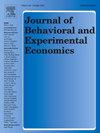态度和行为的差异不是单方面的:有些人对环境的贡献比他们认为的要大
IF 1.4
3区 经济学
Q2 ECONOMICS
Journal of Behavioral and Experimental Economics
Pub Date : 2025-09-25
DOI:10.1016/j.socec.2025.102446
引用次数: 0
摘要
这个激励实验室实验(N=99)将调查测量的环境态度映射到通过努力任务引起的行为上,从而可以分析消极的态度-行为差距(态度超过行为)和积极的差距(行为超过态度)。环境态度采用新生态范式量表进行测量。行为是通过幸存者任务来评估的,在这个任务中,参与者必须至少每20秒按一次空格键来保持任务的运行。只要这项任务保持活跃,它就会为当地一个旨在改善环境的项目筹集捐款。实验不仅揭示了通常讨论的消极态度-行为差距,也揭示了同样大小的积极差距。虽然负差距略大,但有正差距的参与者在182欧元的总捐款中贡献了三倍多的钱。考虑到态度上的性别差异,探索性分析表明,女性表现出的差距比男性小,这表明态度和行为之间的联系更紧密。这与我们的另一个发现一致:态度和行为对女性来说是正相关的,而对男性来说是负相关的。调查结果挑战了人们的普遍看法,即大多数人都没有将自己的态度付诸行动。由于许多人的行为比他们的态度预期的要好,如果忽视了积极的差距,缩小消极差距的努力可能会失败。本文章由计算机程序翻译,如有差异,请以英文原文为准。
The attitude–behavior gap is not one-sided: Some do more for the environment than they believe
This incentivized laboratory experiment () maps survey-measured environmental attitudes onto behavior elicited through an effort task, enabling the analysis of both negative attitude–behavior gaps (where attitudes exceed behavior) and positive gaps (where behavior exceeds attitudes). Environmental attitudes were measured using the New Ecological Paradigm Scale. Behavior was assessed through the Survivor Task, in which participants had to press the spacebar at least once every 20 seconds to keep the task running. As long as the task remained active, it generated donations for a local project aimed at improving the environment. The experiment revealed not only the commonly discussed negative attitude–behavior gap but also a similarly sized positive gap. Although the negative gap was slightly larger, participants with a positive gap contributed three times more to the total donation of €182. Given gender differences in attitudes, exploratory analysis showed that women exhibited smaller gaps than men, indicating a closer alignment between attitudes and behavior. This aligns with our additional finding: attitudes and behavior were positively correlated for women but negatively for men. The results challenge the common belief that most people fail to act on their attitudes. Since many act better than their attitudes predict, efforts to close the negative gap may fail if the positive gap is overlooked.
求助全文
通过发布文献求助,成功后即可免费获取论文全文。
去求助
来源期刊
CiteScore
2.60
自引率
12.50%
发文量
113
审稿时长
83 days
期刊介绍:
The Journal of Behavioral and Experimental Economics (formerly the Journal of Socio-Economics) welcomes submissions that deal with various economic topics but also involve issues that are related to other social sciences, especially psychology, or use experimental methods of inquiry. Thus, contributions in behavioral economics, experimental economics, economic psychology, and judgment and decision making are especially welcome. The journal is open to different research methodologies, as long as they are relevant to the topic and employed rigorously. Possible methodologies include, for example, experiments, surveys, empirical work, theoretical models, meta-analyses, case studies, and simulation-based analyses. Literature reviews that integrate findings from many studies are also welcome, but they should synthesize the literature in a useful manner and provide substantial contribution beyond what the reader could get by simply reading the abstracts of the cited papers. In empirical work, it is important that the results are not only statistically significant but also economically significant. A high contribution-to-length ratio is expected from published articles and therefore papers should not be unnecessarily long, and short articles are welcome. Articles should be written in a manner that is intelligible to our generalist readership. Book reviews are generally solicited but occasionally unsolicited reviews will also be published. Contact the Book Review Editor for related inquiries.

 求助内容:
求助内容: 应助结果提醒方式:
应助结果提醒方式:


